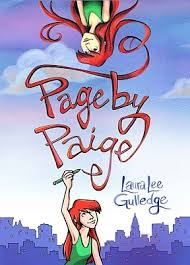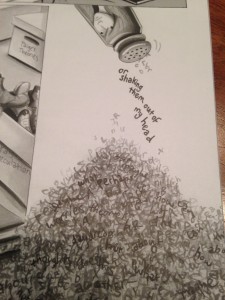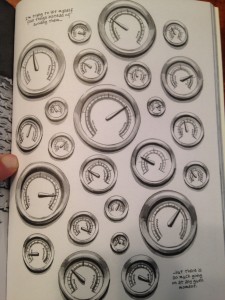 Why I Picked It Up: To be completely honest, Jessica actually picked this one up. We were looking for graphic novels to incorporate into a session we’re working on, and Page by Paige was one that we’d seen in a few places. The play on words in the title made me happy, so even though Jessica picked it up, I got to read it first!
Why I Picked It Up: To be completely honest, Jessica actually picked this one up. We were looking for graphic novels to incorporate into a session we’re working on, and Page by Paige was one that we’d seen in a few places. The play on words in the title made me happy, so even though Jessica picked it up, I got to read it first!
Why I Finished It: Again, in complete honesty, I was a little intimidated by this book. I love graphic novels, partly because they are an “outside the box” way to share a story. This book is even farther outside the outside of that story box. It shares the story of Paige, a girl who has just moved from Virginia to New York and is trying to figure out who she is and how she fits into this new city and her new life. It’s two stories in one – the reality of Paige interacting with her parents, walking around the city and meeting new friends, and the fantasy/imagination/whimsy of what is really going on in her head as she processes those interactions and feelings and works through her identity by drawing in her sketchbook. The illustrations reflect the dual storylines as Paige’s reality is represented mostly in traditional square panels, but her inner monologue completely throws out the conventions of graphic novels and is completely explosive on the pages.
There is so much to look at on every page that it can sometimes be overwhelming, but isn’t that how we sometimes feel while we process our thoughts and feelings? Paige’s character will resonate with a wide variety of readers because she is so complex. While I did want to know what happened to Paige and if/how she resolved her internal struggles, I really found myself just wanting to read one or two pages and then stop to really reflect and study the illustrations. It was almost like many of the pages could stand alone as individual works of art, especially as Paige represents her feelings through metaphors. This is one of my favorite pages – Paige is talking about how she is trying to let herself feel things, “but there is so much going on at any given moment.” Each of the gauges drawn has a pair of extreme emotions (optimism/pessimism, confident/unsure, resilient/fragile, etc.) and the needles are all over the place. Such an amazing visual!
Who I Would Give It To: The theme of finding yourself will probably resonate best with students in middle school and high school (Disclaimer: There are two or three words and subtle issues that might cause concern for some parents, especially for the middle grades, but there is nothing obscene or vulgar). Even though it’s about a girl, I’m pretty sure that it will appeal to both genders. ELA/R teachers could also use the illustrations individually to look at visual literacy and the interaction between language and images.
Integration Ideas
Theme
Relationships – family, friendship, romantic
- How is conflict an inevitable part of relationships?
- How are people transformed through their relationships with others?
- Paige’s friends all reflect back different qualities of herself. How does each friend help her? What traits, qualities, and skills do your friends bring out in you? (From the author’s discussion guide.)
Identity
- How do we form and shape our identities?
- What does it mean to be an insider or an outsider?
Visualization of Figurative Language

There are so many visual illustrations of metaphors and similes in this book that could be studied or serve as a model for drawing your own. Sometimes there are words to accompany the visual that state figurative language, sometimes there aren’t. Find these opportunities to add your own visuals or supply the text.
Grandma’s Rules
There are nine rules outlined by her grandmother that Paige follows throughout the journey. Each rule is presented like the beginning of a chapter.
- No more excuses! Buy a sketchbook and draw a few pages every week.
- Draw what you know. If you feel it or see it…draw it!
- Shhh…quiet…listen to what’s going on in your head.
- Let yourself FAIL. Don’t take it all so personally.
- Figure out what scares you and DO IT!
- Live a LOT to get better material. Let yourself feel everything.
- Stay stimulated to avoid creative constipation.
- Trust your gut instinct. Be honest with yourself.
You can do a lot with these! They have implications in a writers’ workshop as students work to express themselves on paper. Have students choose their favorite rule and write about how it applies to their life. Have students write their own rules for life or add one they think might be missing.
Each rule has a small icon/graphic that goes with it. Have students think about how that image is used throughout the following chapter. How does it symbolize that rule?
Motifs
There are several recurring visual motifs in this book. Have students choose one and follow it through the story, paying close attention to how it is drawn, what it represents and how in different situations, and how it changes over the course of the book. Here are a few options:
- sketchbook
- heart
- picture frames
- physical art (drawings, paintings, comics, sketches, graffiti, etc.)
Graphic Novels
Of course, the interaction between text and images represented in the graphic novel is an excellent opportunity to incorporate visual literacy.
Resources:
Understanding Comics by Scott McCloud
Creating and Reading Comics – extensive resource!
Create one:
http://www.comicmaster.org.uk/
Autobiography
In the author’s note at the end of the book, she says she is a lot like Paige in a several respects. Read this interview with the author and then compare the Paige’s story with the author’s life.







What is the conflict in the Graphic Novel Page by Paige by Laura Lee Gulledge?